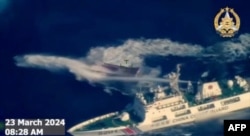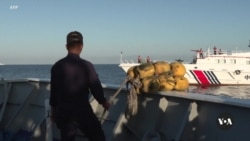U.S. President Joe Biden will host Japanese Prime Minister Fumio Kishida and Philippines President Ferdinand Marcos Jr. in a White House summit set to bolster trilateral maritime cooperation in the South China Sea, a major move to counter Beijing.
The first-of-its-kind gathering by the United States and its two Asian allies is set for Thursday. It’s part of Biden’s strategy to stitch together existing bilateral alliances into broader “mini-laterals” to amplify U.S. influence in Asia.
The U.S.-Japan-Philippines trilateral focuses on freedom of navigation in the South China Sea. Last year, Biden hosted a similar meeting with Japan and South Korea to deal with the threat from North Korea.
Manila is keen to firm up trilateral maritime cooperation, namely plans for joint naval patrols by the three countries, a move that would likely trigger a strong reaction from Beijing.
“Joint patrols are something that we've already discussed extensively with Japan and the United States,” Philippines Ambassador to the U.S. Jose Manuel Romualdez told reporters in a briefing last week. “And I think that we're hoping that this will come into fruition very soon.”
The White House declined to confirm such plans, reiterating only that the leaders would have much to discuss in their meeting.
“Certainly, the tensions in the South China Sea are not going away,” said national security spokesperson John Kirby in response to VOA’s question during a White House briefing Thursday. “That was an issue that was raised in the president's call with President Xi [Jinping of China] just a couple of days ago.”
Pentagon press secretary Pat Ryder also declined to confirm, telling VOA only that the goal of trilateral efforts in the South China Sea is to “ensure that the Indo-Pacific region remains free, it remains open and that there is security and stability throughout the region.”
However, an announcement on joint naval patrols is “widely expected” at the summit, said Gregory Poling, director of the Center for Strategic and International Studies' Southeast Asia Program and Asia Maritime Transparency Initiative. Following increased Philippine naval activities with regional partners including the United States, Japan and Australia, the trilateral naval patrol “is an obvious next step,” he told VOA.
The meeting and expected announcement will come amid ramped-up tension in the South China Sea, where for weeks Chinese coast guard ships have deployed water cannons against Philippine vessels to block a resupply mission to the Second Thomas Shoal.
Since 1999, Philippine soldiers have guarded a wrecked ship left on the shoal to maintain the country’s sovereignty claims over the Spratly Islands in the South China Sea.
The Philippines is a U.S. ally under the 1951 Mutual Defense Treaty, which means skirmishes between Manila and Beijing in the Spratlys are a problem for Washington.
“While we're focused on Taiwan for obvious reasons, conflict between the U.S. and China remains more likely in the South China Sea,” Poling told VOA. “The ceiling on that might be lower; we're not going to escalate into a general war in the South China Sea. But a lower-level military conflict is uncomfortably possible.”
More robust Japan role
The South China Sea is a vital passageway for Japan's global supply chains, a reaffirming factor for Tokyo as Washington draws it into a more robust military role in the region.
“There is tremendous expectation for Japan,” said Shihoko Goto, director of the Indo-Pacific Program at the Wilson Center.
Tokyo is “at the heart of regional security,” she told VOA, considering its involvement in the two trilateral formations and in the quadrilateral strategic security dialogue among Australia, India, Japan and the United States, also known as the Quad.
For Japan's Kishida, the summit will be another chance to flex his country’s diplomatic muscles as it stands beside Washington, its strongest ally.
Kishida wants to showcase the transformation of Japan’s bilateral alliance with Washington that serves peace and stability in the Indo-Pacific to a “global partnership that stands as the cornerstone of international liberal order,” said Yuki Tatsumi, co-director of the East Asia Program and director of the Japan Program at the Stimson Center.
The key deliverables, she told VOA, include plans for a modernized alliance command and control and plans for a consultative body for defense industrial cooperation.
Japan has been an anchor of various U.S. regional alliances and partnership in the region. Ahead of the summit, Tokyo and Manila are already in talks on a Reciprocal Access Agreement that would enhance shared military operations and training.
US lagging on building prosperity
While many analysts applaud Biden on his strong and coordinated security approach for the region, they say Washington is lagging Beijing when it comes to building regional prosperity.
“We're not seeing as much leadership on the economic front,” Goto said. “That will be something that there will be greater demand for.”
In previous meetings with Biden, Kishida reiterated Japan’s calls for Washington to join the 2018 Comprehensive and Progressive Agreement for Trans-Pacific Partnership.
The 11-country bloc representing one of the largest free-trade areas in the world is a reincarnation of the Trans-Pacific Partnership, a free-trade agreement pushed in 2015 by then-President Barack Obama and then-Prime Minister Shinzo Abe.
Then-President Donald Trump withdrew from the TPP in 2017.
Kishida and Biden are also likely to discuss Nippon Steel’s proposed acquisition of U.S. Steel. Ahead of the American presidential election in November, the potential deal has become embroiled in protectionist campaign rhetoric.
Biden sees steel as critical to national security and has said the company should remain domestically owned. His prospective opponent, Trump, has promised to block the $14 billion deal if he is elected again.
Trilateral aside, Biden will honor Kishida, whom he last met at the G7 summit in Hiroshima last year, with an official visit Wednesday. He will meet separately with Marcos on Thursday, a repeat of the Philippines leader’s White House visit last May.
Analysts say the frequent meetings with the leaders underscore Biden’s desire for the U.S. to remain a Pacific power, despite the president’s focus being pulled toward the conflicts in Ukraine and Gaza.
Carla Babb and Paris Huang contributed to this report.
Editor's note: An earlier version of this report misspelled Gregory Poling's last name. VOA regrets the error.












